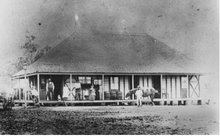 I’ve been thinking about how different and strange the plants in Australia must have seemed to German eyes. I’ve written about how odd the greenness and lushness of European and Midwestern American foliage appeared to my eyes. Similarly Australia’s native forests must have disconcerted many on arrival.
I’ve been thinking about how different and strange the plants in Australia must have seemed to German eyes. I’ve written about how odd the greenness and lushness of European and Midwestern American foliage appeared to my eyes. Similarly Australia’s native forests must have disconcerted many on arrival. In the spareness of much native flora, there is an elusive beauty. There is the appreciation of the many shades of subtle green. There are the sometimes astonishing changes with season. There are the distinct beauties of texture (new bark versus old bark, fruiting nuts and dried cases, fluffy flowers), form (sinuous curves, twiggy outcrops, reaching for the sky) and there are the changing colours of leaf, bark and flower.
In the spareness of much native flora, there is an elusive beauty. There is the appreciation of the many shades of subtle green. There are the sometimes astonishing changes with season. There are the distinct beauties of texture (new bark versus old bark, fruiting nuts and dried cases, fluffy flowers), form (sinuous curves, twiggy outcrops, reaching for the sky) and there are the changing colours of leaf, bark and flower. I have to interject here a family anecdote about my grandparents’ trip to America in the 1960s. They visited relatives on the East Coast and also spent some time in Texas. Taken touring there by a local, all the gum trees were pointed out to them with great pride as “you probably ain’t used to our eucalypts.” The Texan gentleman refused to believe my grandfather’s assertions that eucalypts are native to Australia and that he indeed was used to them.
I have to interject here a family anecdote about my grandparents’ trip to America in the 1960s. They visited relatives on the East Coast and also spent some time in Texas. Taken touring there by a local, all the gum trees were pointed out to them with great pride as “you probably ain’t used to our eucalypts.” The Texan gentleman refused to believe my grandfather’s assertions that eucalypts are native to Australia and that he indeed was used to them. Every year the lemon scented gum in our garden changes almost overnight. One day it is a stately brown clad matron. The next it seems to burst out of its skin, shrugging pinkish bark off in tatters to reveal pure ivory flesh which shades to green in the sunlight. Then slowly over months, it shrouds itself again.
Every year the lemon scented gum in our garden changes almost overnight. One day it is a stately brown clad matron. The next it seems to burst out of its skin, shrugging pinkish bark off in tatters to reveal pure ivory flesh which shades to green in the sunlight. Then slowly over months, it shrouds itself again.These changes have become part of the fabric of our lives but the first cycle was astonishing. Imagine if you had never seen such changes. All trees changes with seasons but many trees here are not deciduous. If they lose leaves, it is often linked to available water, not temperature. Many trees that are deciduous elsewhere are not so here. And many native trees do look sparse as they struggle to conserve moisture in narrow waxy leaves or spines.













